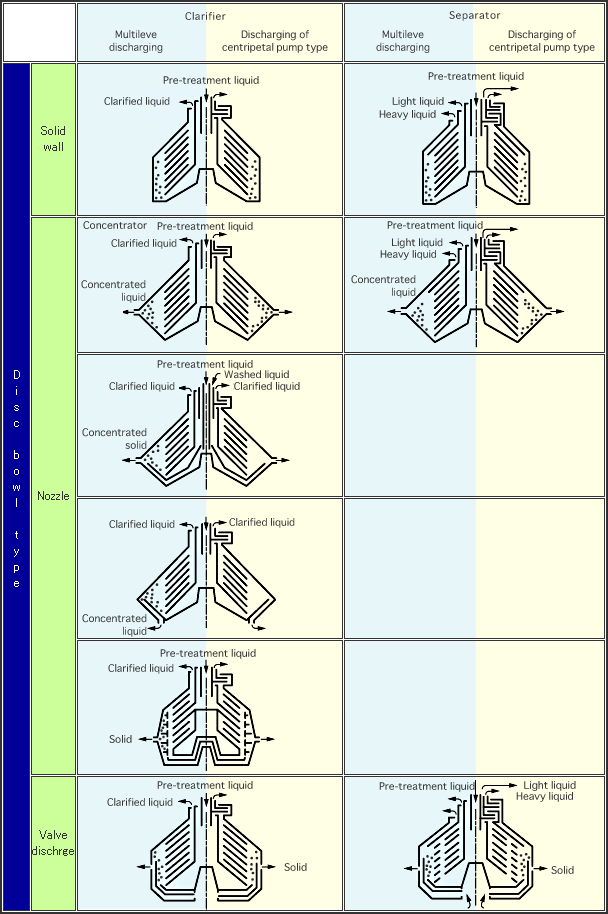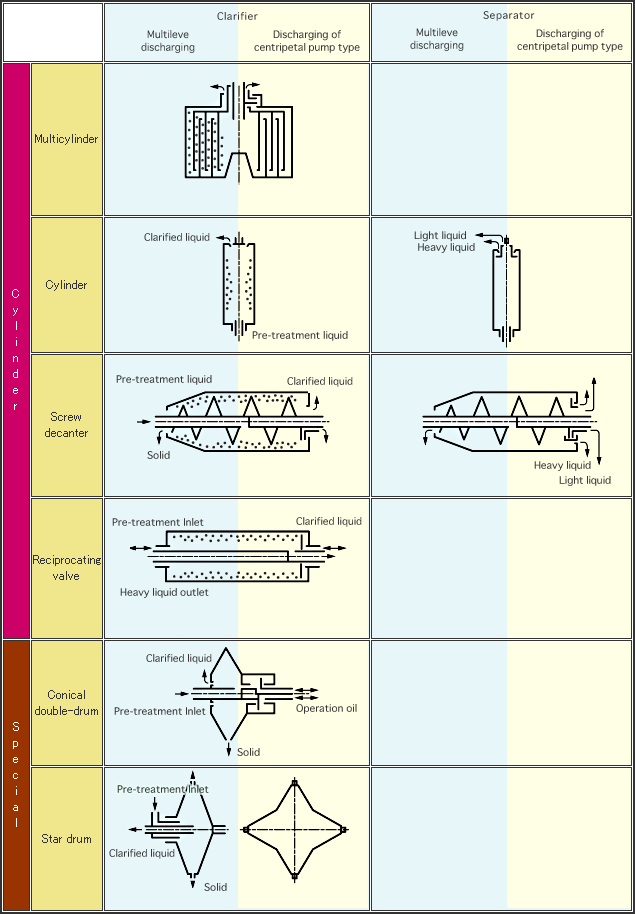- Home
- What is a separator?
- Basic of function selection
Basic of function selection
Purification (liquid - liquid) or Clarification separation (solid - liquid) can be determined easily by the separation purpose. What is most important for selecting the model is the solid content in the liquid to be treated, which is based on the volume concentration.
For model selection, the solid content discharging capacity must be considered together with the separative efficiency.
The points to be noted for model selection considering solid content concentration are given below.
Solid content with very low concentration (less than 1%)
(1)Disk-type, solid wall model
(2)Cylinder type, Sharpless model
(3)Cylinder type, multicylinder model
For these models without a solid content discharging mechanism, the solid contents are extracted manually by disassembling the bowl part.Therefore, the contained solid content concentration is limited by the allowable frequency of the related field.
Solid content with low concentration (less than few %)
(1)Disk-type, valve discharging model
(2)Cylinder type, reciprocating valve model
These models have a mechanism for discharging solid contents. Whenever solid contents accumulate to a certain level in the solid content holding area of the bowl part, the solid contents are automatically discharged by time control or another kind of automatic control.
Solid content with medium concentration (few % or more)
(1)Disk type, nozzle model
(2)Disk type, nozzle 3-phase model
(3)Special type
The nozzle model and the special star rotary drum model continuously discharge solid contents as concentrated slurry from several nozzles of small diameter. Other machines have a large sludge space for solid contents.
Solid contents with high concentration (10% or more)
(1)Cylinder type, spiral discharging model (screw decanter)
The solid contents separate and settle on the wall in the rotary drum and are continuously discharged out of the bowl part with the screw conveyor. The obtained solid content concentration is the highest. This type of machine is sometimes used for dehydration.
The descriptions given above are just guidelines for selecting the model. Because the appropriateness of the model is also determined by the physical properties of the materials treated, carefully select the optimum model considering the principle and mechanism for discharging solid contents.
Figure 2 shows conceptual drawings of bowl part of individual models.
(Figure 2) Disc bowl type

(Figure 2) Cylinder/Special

In addition, for food industry, cleaning and sterilizing performances should also be considered when selecting the model.
For centrifugal separators for foods, CIP has been taken into consideration , though there are some points to be noted about extracting the separated liquid.
There are two types of liquid extraction: over flow and centripetal pump types. In type, the separated liquid is overflowed from the bowl part to the receiver, dropped, and flowed out of the machine.
Because the separated liquid is flowed out of the rapidly bowl part, it is sprayed out and has a very wide area of contacted with the outside air as a result. Advantages and disadvantages for this phenomenon should be considered.
On the other hand, in the centripetal pump type, the liquid rapidly rotating in the bowl part is directly discharged to the connected pipe by converting the velocity of the rotating liquid to pressure. Thus, there is little contact with the outside air and a debubbling effect is also provided.
